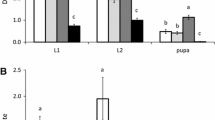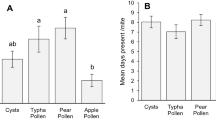Abstract
Typhlodromus pyri Scheuten (Acari: Phytoseiidae) is the most important predator of Panonychus ulmi (Koch) (Acari: Tetranychidae) in orchards and vineyards. It was recently found that adult T. pyri females cause microscopic scars on apple leaves. The present laboratory experiments were carried out to confirm the production of scars on apple leaves and to assess if females cause scars on fruits as well. Scar production on apple leaves and/or fruits was investigated under various nutritional conditions: no food, pollen of Scots pine (Pinus sylvestris L.) only, nymphs of P. ulmi only, and pollen + prey. Both on leaves and fruits, either offered alone or in combination, feeding scars were produced under all nutritional conditions, but mostly in the ‘no food’ treatment. The predators consumed significantly more P. ulmi nymphs when offered alone than when offered in combination with pollen. T. pyri laid eggs under all nutritional conditions, but mostly in the ‘pollen + prey’ treatment and least when no food was offered. T. pyri females caused scars on both leaves and fruits when offered simultaneously, but more on leaves than on fruits. The scars were also bigger on leaves than on fruits in all experiments. T. pyri survived and reproduced on plant material in the absence of other food sources. Whether the scars produced on leaves and fruits harm the quality of fruits or the yield of apple cannot be concluded from the present experiments.
Similar content being viewed by others
References
Alomar O. and Albajes R. 1996. Greenhouse whitefly (Homoptera: Aleyrodidae) predation and tomato fruit injury by the zoophytophagous predator Dicyphus tamaninii (Heteroptera: Miridae). In: Alomar O. and Wiedenmann R.N. (eds) Zoophytophagous Heteroptera: Implications for Life History and Integrated Pest Management. Bulletin of the Entomological Society of America, Lanham, Maryland, USA, pp. 155–177.
Armer C.A., Wiedenmann R.N. and Irwin M.E. 1999. Effects of soybean mosaic virus on the facultative phytophagous predator Orius insidiosus (Heteroptera: Anthocoridae). Environ. Entomol. 28(6): 1036–1043.
Camporese P. and Duso C. 1996. Different colonization patterns of phytophagous and predatory mites (Acari: Tetranychidae, Phytoseiidae) on three grape varieties: a case study. Exp. Appl. Acarol. 20(1): 1–22.
Chant D.A. 1959. Phytoseiid mites (Acari: Phytoseiidae). Part I. Bionomics of seven species in southeastern England. Can. Entomol. 91(12): 1–44.
Coll M. and Guershon M. 2002. Omnivory in terrestrial arthropods: mixing plant and prey diets. Ann. Rev. Entomol. 47: 267–297.
Coll M. and Ruberson J.R. 1998. Predatory Heteroptera: Their Ecology and Use in Biological Control. Thomas Say Publications, Entomological Society America, Lanham, Maryland, USA.
Dosse G. 1961. Ü ber die Bedeutung der Pollennahrung für Typhlodromus pyri Scheuten (Acari: Phytoseiidae). Entomol. Exp. Appl. 4: 191–195.
Duso C. and Camporese P. 1991. Developmental times and oviposition rates of predatory mites Typhlodromus pyri and Amblyseius andersoni (Acari: Phytoseiidae) reared on different foods. Exp. Appl. Acarol. 13: 117–128.
Duso C. and Pasqualetto C. 1993. Factors affecting the potential of phytoseiid mites (Acari: Phytoseiidae) as biocontrol agents in north-Italian vineyards. Exp. Appl. Acarol. 17(4): 241–258.
Engel R. and Ohnesorge B. 1994. The role of alternative food and microclimate in the system Typhlodromus pyri (Acari: Phytoseiidae) Panonychus ulmi (Acari: Tetranychidae) on grapevines. 2. Field experiments. J. Appl. Ent. 118(3): 224–238.
Gabarra R., Castane C., Bordas E. and Albajes R. 1988. Dicyphus tamaninii as a beneficial insect and pest in tomato crops in Catalonia, Spain. Entomophaga 41: 219–228.
Magalhaes S. and Bakker F.M. 2002. Plant feeding by a predatory mite inhabiting cassava. Exp. Appl. Acarol. 27: 27–37.
McGregor R.R., Gillespie D.R., Park C.G., Quiring D.M.J. and Foisy M.R.J. 2000. Leaves or fruit? The potential for damage to tomato fruits by the omnivorous predator, D. hesperus. Ent. Exp. Appl. 95: 325–328.
McMurtry J.A. and Croft B.A. 1997. Life-styles of Phytoseiid mites and their roles in biological control. Ann. Rev. Entomol. 42: 291–321.
McMurtry J.A. and Rodriguez J. 1987. Nutritional ecology of phytoseiid mites. In: Slansky F. and Rodriguez J. (eds) Nutritional Ecology of Insects, Mites and Spiders. Wiley and Sons, New York, p. 1016.
Overmeer W.P.J. 1985. Alternative prey and other food resources. In: Helle W. and Sabelis M.W. (eds) Spider Mites — Their Biology, Natural Enemies and Control. Elsevier Science Publishers, Amsterdam, The Netherlands, pp. 137–139.
Papaioannou-Souliotis P., Markoyiannaki-Printziou D., Rumbos I. and Adamopoulos I. 1999. Phytoseiid mites associated with vine in various provinces of Greece: a contribution to faunistics and biogeography, with reference to eco-ethological aspects of Phytoseius finitimus (Ribaga) (Acari: Phytoseiidae). Acarologia 40(2): 113–125.
Porres M.A., McMurtry J.A. and March R.B. 1975. Investigation of leaf sap feeding by three species of phytoseiid mites by labelling with radioactive phosphoric acid (H3 32PO4). Ann. Entomol. Soc. Am. 68: 871–872.
Sampson C. and Jacobson R.J. 1999. Macrolophus caliginosus Wagner (Heteroptera: Miridae): a predator causing damage to UK tomatoes. IOBC/WPRS Bull. 22: 213–216.
Schausberger P. 1998. Population growth and persistence when prey is diminishing in single-species and two-species systems of the predatory mites Euseius finlandicus, Typhlodromus pyri and Kampimodromus aberrans. Entomol. Exp. Appl. 88(3): 275–286.
Sengonca C., Schade M. and Schütze A. 1994. Vorkommen und Ausbreitung der Raubmilbe Typhlodromus pyri Scheuten in nordrheinischen Apfelanbaugebieten. Erwerbsobstbau 36: 204–207.
Sengonca C., Saleh A. and Blaeser P. 2003. Investigations on the potential damage caused to cucumber fruit by the polyphagous predatory bug Dicyphus tamaninii Wagner (Heteroptera: Miridae) under different nutritional conditions. J. Plant Dis. Protect. 110(1): 59–65.
Solomon M.G., Easterbrook M.A. and Fitzgerald J.D. 1993. Mite-management programs based on organophosphate-resistant Typhlodromus pyri in UK apple orchards. Crop Protect. 12(4): 249–254.
Wei Q. and Walde S.J. 1997. The functional response of Typhlodromus pyri to its prey, Panonychus ulmi: the effect of pollen. Exp. Appl. Acarol. 21: 677–684.
Zaher M.A. and Shehata K.K. 1971. Biological studies on the predator mite Typhlodromus pyri Scheuten (Acari: Phytoseiidae) with the effect of prey and non-prey substances. Z. Ang. Entomol. 67: 389–394.
Author information
Authors and Affiliations
Corresponding author
Rights and permissions
About this article
Cite this article
Sengonca, C., Khan, I.A. & Blaeser, P. The predatory mite Typhlodromus pyri (Acari: Phytoseiidae) causes feeding scars on leaves and fruits of apple. Exp Appl Acarol 33, 45–53 (2004). https://doi.org/10.1023/B:APPA.0000029965.47111.f3
Issue Date:
DOI: https://doi.org/10.1023/B:APPA.0000029965.47111.f3




